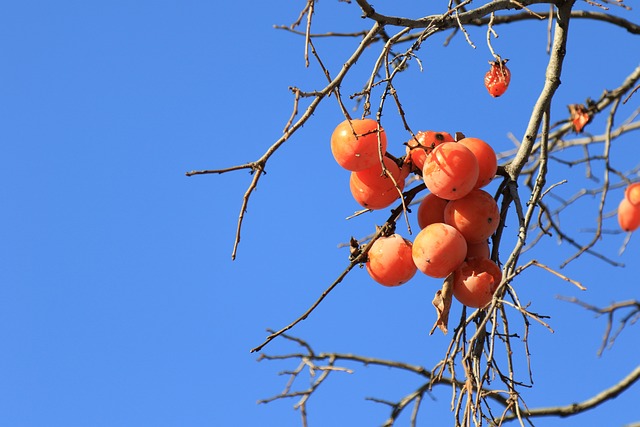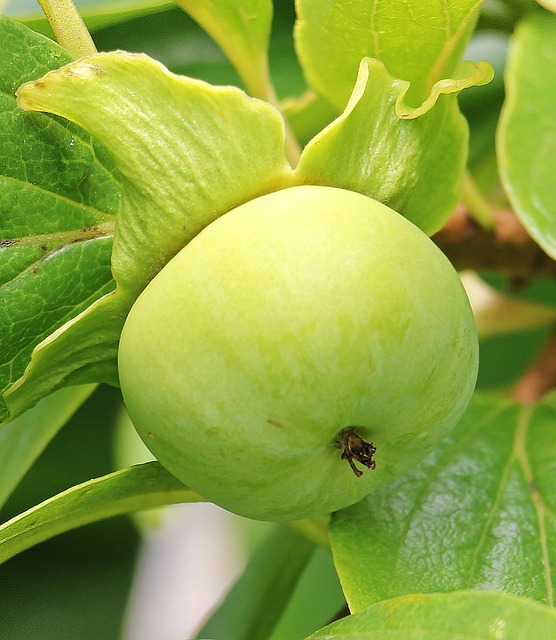Persimmons: The Puzzling Fruit That Can Leave Your Mouth Dry
Welcome to the intriguing world of persimmons! These vibrant orange fruits have captivated taste buds and puzzled senses for centuries. With their unique flavor and remarkable ability to leave your mouth dry, persimmons have sparked curiosity and fascination among fruit enthusiasts and curious eaters alike. Get ready to embark on a delightful journey through the origins, flavors, and mysteries surrounding this extraordinary fruit. Whether you’re a seasoned persimmon aficionado, or simply intrigued by the idea of a fruit that defies expectations, this article will provide you with all the fascinating information you need to know about persimmons. So grab a seat, relax, and get ready to uncover the secrets of this puzzling fruit that can leave your mouth delightfully dry.
1. What Are Persimmons and Why Are They So Puzzling?
Persimmons are a unique fruit that may leave you scratching your head. Native to Asia, they have a distinct appearance resembling an orange tomato. With their vibrant orange color and smooth skin, they are hard to miss in the produce aisle.
But what sets persimmons apart is their perplexing taste. When fully ripe, they become incredibly sweet and have a honey-like flavor. However, when eaten before fully ripened, they can be mouth-puckeringly astringent, leaving an unpleasant, chalky feeling in your mouth. This phenomenon has led to the saying, “You can eat a persimmon when it’s hard as a rock or soft as a pillow, but never in between!”
– Persimmons are native to Asia.
– Their appearance resembles an orange tomato.
– Fully ripe persimmons have a sweet honey-like taste.
– Eating unripe persimmons can leave a chalky feeling in your mouth.
– The saying goes, “You can eat a persimmon when it’s hard as a rock or soft as a pillow, but never in between!
2. Unraveling the Mystery: A Beginner’s Guide to the Enigmatic Persimmons
Are you eager to learn more about persimmons? Look no further! In this guide, we will unravel the mystery and introduce you to the wonderful world of these enigmatic fruits.
Types of Persimmons:
1. Fuyu Persimmons: Known for their tomato-like shape, Fuyu persimmons are the most common variety found in grocery stores. They have a crisp texture and can be eaten while still firm or when fully ripe. Their sweet flavor has notes of honey and vanilla, making them a delightful addition to salads or as a snack.
2. Hachiya Persimmons: Hachiya persimmons are elongated and have a unique, acorn-like shape. They are known for their melt-in-your-mouth, custard-like flesh. However, it’s essential to let them ripen fully, as unripe Hachiya persimmons are extremely astringent and unpleasant to eat. When ripe, they are perfect for baking, making jams, or adding a sweet twist to smoothies.

3. From Sweet to Astringent: Understanding the Different Types of Persimmons
Persimmons are a versatile fruit that come in several different varieties, each with its own unique flavor profile and texture. Understanding the differences between these types of persimmons will help you make the most of this autumnal treat. Here are three types of persimmons, ranging from sweet to astringent:
Fuyu Persimmons:
- Fuyu persimmons are the most popular variety and are widely available.
- They have a sweet, honey-like flavor and can be enjoyed when firm or slightly soft.
- Fuyu persimmons are pale orange in color and have a crisp texture, similar to an apple.
Hachiya Persimmons:
- Hachiya persimmons have a more pronounced astringency and need to be fully ripe before consuming.
- They have a vibrant orange color and a soft, jelly-like texture when fully ripe.
- Hachiya persimmons are incredibly sweet and have a rich, custard-like flavor.
- These persimmons are best used in baked goods, smoothies, or enjoyed as a dessert on their own.
When selecting persimmons, look for fruits that are vibrant in color, free of blemishes, and have a slight give when gently pressed. Experiment with different varieties to discover your favorite or try incorporating them into recipes for a delightful and nutritious addition to your fall menu!

4. Did You Know? Persimmons Can Leave Your Mouth Dry – Here’s Why!
When you bite into a ripe and juicy persimmon, you may not expect it to leave your mouth feeling dry, but it’s a common occurrence for many. The culprit behind this unexpected sensation is the high tannin content found in persimmons. Tannins are naturally occurring compounds that contribute to the astringent taste and drying effect in certain fruits, such as persimmons.
So, how do tannins cause dryness? These compounds bind to the proteins and salivary molecules in your mouth, reducing their ability to lubricate and hydrate. As a result, your mouth may feel dry and puckered after eating persimmons. The good news is that not all persimmons contain the same amount of tannins. Varieties like Fuyu tend to have lower tannin levels, making them less likely to leave you feeling parched.
Here are a few tips for mitigating the dryness:
- Pair persimmons with foods that have a higher moisture content, such as yogurt or a glass of water.
- Opt for less astringent persimmon varieties like Fuyu or Jiro.
- Allow persimmons to fully ripen before consuming, as the tannin levels decrease as they ripen.
- Consider consuming persimmons in moderation or alongside other fruits to balance out the dryness.
Next time you indulge in the sweet and vibrant flavor of a persimmon, remember to stay hydrated and pair it with other hydrating foods to enjoy this delicious fruit to the fullest!

5. The Science Behind the Puckering: Exploring the Chemical Composition of Persimmons
Have you ever wondered why persimmons make your mouth pucker? It turns out, there’s some fascinating science behind this unique sensation. Let’s delve into the chemical composition of persimmons and uncover the secrets behind their mouth-watering taste.
1. **Tannins**: One of the main contributors to the puckering effect in persimmons is a group of compounds called tannins. These natural plant chemicals are responsible for the astringency, or dryness, that you feel in your mouth when you bite into an unripe persimmon. As the fruit ripens, however, the tannin levels decrease, resulting in a sweet and enjoyable eating experience.
2. **Vitamin C**: Persimmons are packed with vitamin C, which not only boosts your immune system but also adds a refreshing tartness to the fruit. This vitamin acts as an antioxidant, preventing the fruit from oxidizing and allowing it to retain its vibrant color and delightful flavor.
6. Keeping the Mouth Moist: Tips and Tricks to Enjoying Persimmons to the Fullest
One of the challenges of enjoying persimmons is their tendency to make your mouth feel dry. However, fret not! We’ve compiled some handy tips and tricks to help you keep your mouth moist while savoring the delightful flavor of persimmons.
First and foremost, make sure to hydrate well before indulging in this delicious fruit. Drinking a glass of water or any other hydrating beverage will help maintain moisture levels in your mouth, making your persimmon experience all the more enjoyable. Additionally, consider the following tips:
- Sip on a refreshing drink: Keep a glass of water, herbal tea, or fruit-infused water nearby while eating persimmons. Taking regular sips will help you combat dryness and fully relish the taste.
- Pair persimmons with moist foods: Enjoying persimmons alongside some moist, juicy foods can lend balance to the dryness. Try pairing them with Greek yogurt, cottage cheese, or adding slices to a refreshing salad.
- Try freezing persimmons: Frozen persimmons not only provide a unique twist but also introduce a cooling effect that can alleviate dryness. Simply peel and slice the fruit, then store the pieces in the freezer for a refreshing treat.
By following these tips, you’ll be able to fully immerse yourself in the wonderful world of persimmons without any mouth dryness. So go ahead, savor this luscious fruit to the fullest and enjoy every juicy bite!
7. Recipes Galore: Creative Ways to Incorporate Persimmons into Your Culinary Adventures
Persimmons, with their rich flavor and vibrant color, are a versatile fruit that can add a delightful twist to your culinary creations. Whether you have a bountiful supply of fresh persimmons or you’re looking to try something new, we’ve got you covered with some inspiring recipes that will make your taste buds dance.
1. Persimmon Salad: Start your culinary adventure by tossing together a refreshing persimmon salad. Mix sliced persimmons with fresh arugula, crumbled goat cheese, and toasted walnuts. Drizzle with a tangy dressing made from olive oil, honey, and lemon juice. The combination of sweet, tart, and creamy flavors will leave you craving more.
2. Persimmon Salsa: Give your favorite Mexican dishes a burst of flavor with a homemade persimmon salsa. Combine diced persimmons, tomatoes, red onion, jalapeño peppers, cilantro, lime juice, and a pinch of salt. Serve this zesty salsa with grilled fish or as a tasty topping for tacos and quesadillas. It’s a delightful balance of spicy and sweet.
3. Persimmon Bread: Warm up your kitchen and treat yourself to a delicious persimmon bread. Mash ripe persimmons and fold them into a spiced batter with cinnamon, nutmeg, and vanilla extract. Bake until golden brown, and relish the aroma that fills the air. Enjoy a slice with a hot cup of tea or coffee for a cozy afternoon treat.
These are just a few ways to kick-start your culinary adventure with persimmons. From savory dishes to sweet treats, persimmons can elevate your cooking to new heights. So, grab some persimmons and get creative in the kitchen!
8. The Health Benefits of Persimmons: From Vitamins to Antioxidants
Persimmons are not only delicious, but they also offer a plethora of health benefits that can contribute to overall well-being. Packed with essential vitamins and antioxidants, these vibrant fruits can support various aspects of our health:
1. Immune System Boost: Persimmons are rich in vitamin C, which plays a crucial role in enhancing our immune system. This powerful antioxidant helps to protect our cells from damage, promotes the production of collagen for healthy skin, and aids in the absorption of iron.
2. Heart Health: The high fiber content in persimmons helps to lower bad cholesterol levels and maintain a healthy heart. Additionally, the abundance of potassium in these fruits can help regulate blood pressure and reduce the risk of cardiovascular diseases.
3. Digestive Health: With their high fiber content, persimmons promote healthy digestion by preventing constipation and maintaining regular bowel movements.
4. Eye Health: Loaded with vitamins A and C, persimmons contribute to good eye health. These vitamins act as antioxidants that protect the eyes from free radical damage and age-related macular degeneration.
Next time you come across persimmons in your local grocery store or farmers market, consider adding these delightful fruits to your basket to reap their incredible health benefits!
9. Persimmons Around the World: Discovering How Different Cultures Enjoy This Perplexing Fruit
Persimmons are a versatile fruit beloved by different cultures around the world. From Asia to the Americas, people have found numerous ways to enjoy the unique flavors and textures of these perplexing fruits. Let’s take a virtual trip and explore how different cultures incorporate persimmons into their culinary traditions:
In Japan, persimmons hold a special place in the hearts of locals. They are often used in traditional sweets like wagashi, which are beautifully crafted confections typically served with tea. One popular type of wagashi made with persimmons is called “kaki no hachimitsu,” or persimmons marinated in honey. These treats are known for their delicate balance of sweetness and slight tartness, creating a delightful experience for the taste buds.
- In Peru, the persimmon takes on a different role in the traditional dish called “chirimoya con persimmon.” This refreshing dessert combines the sweetness of persimmons with the creamy texture of chirimoya, a tropical fruit native to the region. The persimmons add a delightful crunch to the smooth chirimoya pulp, making it a perfect dessert for hot summer days.
- Over in South Korea, persimmons are often dried to make a popular treat known as “gotgam.” This dried persimmon snack is a favorite during the winter months and is enjoyed as a natural and healthy alternative to sugary snacks. The drying process enhances the natural sweetness and intensifies the flavors, resulting in a chewy and satisfying snack.
- In Brazil, persimmons are commonly used in salads, adding a burst of vibrant color and refreshing sweetness. They are often combined with greens, cheeses, and nuts to create a balanced and nutritious dish. The contrasting textures and flavors make for an enticing salad that is popular among locals and visitors alike.
These are just a few examples of how persimmons are enjoyed in different cultures around the world. From decadent desserts to healthy snacks and savory dishes, the versatility of persimmons makes them a beloved fruit worldwide. So, why not embark on your own culinary adventure and discover new and delicious ways to enjoy this perplexing fruit?
10. Embracing the Challenge: Conquering the Astringency of Persimmons Like a Pro
When it comes to persimmons, the astringency can be a real challenge, leaving many people hesitant to enjoy these delicious fruits. But fear not! We’re here to help you conquer the astringency like a pro, so you can indulge in the sweet, creamy goodness of persimmons without any puckering. Here are some tried and true tips to embrace the challenge and become a persimmon connoisseur.
1. Choose the right persimmons: To avoid overwhelming astringency, go for fully ripe persimmons. Look for ones that are soft to the touch with a slightly wrinkled skin. These are the ones that will be sweet and delicious without the harshness.
2. Let them ripen: If you happen to get your hands on unripe persimmons, don’t fret! Simply place them in a paper bag with a banana or apple, and let them ripen at room temperature. The natural ethylene gas produced by the fruits will help speed up the ripening process.
3. Remove the puckering tannins: To further reduce astringency, you can try removing the tannins. One method is to freeze the persimmons overnight and then allow them to thaw completely. The freezing process breaks down the tannins, resulting in a milder taste.
4. Enjoy different varieties: Persimmons come in various types, such as Fuyu and Hachiya. Fuyu persimmons are non-astringent when firm and can be sliced and eaten like an apple. Hachiya persimmons, on the other hand, are astringent and require thorough ripening and softening before consuming or using them for baking.
Embracing the challenge of conquering the astringency of persimmons may require a little patience and experimentation. But with these tips, you’ll be well on your way to enjoying the unique flavor and texture of this delightful fruit. So go ahead, grab a persimmon, and savor the sweetness!
Frequently Asked Questions
Q: What are persimmons?
A: Persimmons are a unique fruit that originated in East Asia and have been enjoyed for thousands of years. They belong to the genus Diospyros and are known for their distinct taste and vibrant orange color when ripe.
Q: Why are persimmons sometimes called the “puzzling fruit”?
A: Persimmons have gained this nickname because their flavor and texture can be quite surprising to those who have never tasted them before. Some persimmon varieties, particularly the Hachiya type, can leave your mouth feeling dry and “puckery” if eaten before they are fully ripe.
Q: Are all persimmons drying to the mouth?
A: No, not all persimmons will leave your mouth dry. The astringency, which causes the dry sensation, is a characteristic of certain persimmon varieties, mainly the Hachiya and some wild persimmons. Other types, like the Fuyu variety, can be eaten while still firm and crisp, offering a sweet and juicy experience.
Q: How can I tell if a persimmon is ripe and ready to eat?
A: The method of determining ripeness depends on the type of persimmon you have. Hachiya persimmons need to be extremely soft and gently squishy, almost resembling a water balloon, before they are fully ripe. Fuyu persimmons, on the other hand, should be firm with a little give, similar to a ripe tomato.
Q: What can I do if I accidentally eat an unripe persimmon?
A: If you find yourself with an unripe persimmon that leaves your mouth feeling dry, there are a few remedies you can try. One method is to sprinkle a little salt on the fruit to counteract the astringency. Alternatively, you can try cooking unripe persimmons, as heat can help neutralize the drying effect.
Q: What are some ways to enjoy ripe persimmons?
A: Ripe persimmons have a wonderful sweet flavor and are very versatile. They can be enjoyed fresh as a delightful snack or used in various recipes. They make a great addition to salads, smoothies, and baked goods. Some people also dry persimmons to create a chewy and delicious treat.
Q: Are persimmons nutritious?
A: Absolutely! Persimmons are not only delicious but also packed with nutrients. They are a good source of vitamins A and C, as well as dietary fiber. Additionally, persimmons contain various beneficial plant compounds, such as antioxidants, which contribute to their health-promoting properties.
Q: Are persimmons available year-round?
A: Persimmons are a seasonal fruit, with availability varying depending on your location. In most places, persimmons are harvested in the fall and can be found fresh in stores and local markets during that time. However, frozen and dried persimmons can often be found throughout the year.
Q: Any final tips for enjoying persimmons?
A: Yes! When enjoying persimmons, remember to select the appropriate variety for your desired taste and texture. If you’re trying astringent persimmons like the Hachiya, be patient and wait until they are fully ripe. Don’t let the drying experience deter you from trying different persimmon varieties, as the sweet, juicy ones are a real delight!
Conclusion
So there you have it, the puzzling fruit that can leave your mouth dry – persimmons! As we delved into the intriguing world of these delicious gems, we discovered their remarkable history, diverse varieties, and health benefits. From their origins in ancient China to their journey across continents, persimmons have captivated people’s taste buds for centuries.
Whether you prefer the astringency of the Hachiya variety or the sweet crunch of the Fuyu, there’s a persimmon out there for everyone. These versatile fruits can be enjoyed in a myriad of ways, from being savored fresh to incorporating them into mouthwatering recipes such as salads, jams, or even baked goods.
But remember, patience is key when it comes to persimmons. Wait until they are perfectly ripe, soft, and jelly-like to avoid that mouth-drying sensation caused by tannins. And fear not, even if you accidentally bite into an unripe persimmon, you can always turn it into a delectable treat by drying it or using it as an ingredient in certain traditional dishes.
Aside from their exquisite flavor, persimmons offer a host of health benefits. Packed with vitamins, minerals, and antioxidants, they can boost your immune system, improve digestion, and support heart health. So, adding persimmons to your diet not only pleases your taste buds but also nourishes your body.
Next time you encounter this enigmatic fruit at your local market or find it presented on a plate in a restaurant, embrace the mystery of persimmons and give them a chance to surprise you. Explore the various varieties, experiment with recipes, and let their unique taste and texture awaken your culinary senses.
So go ahead, join the ranks of persimmon enthusiasts, and enjoy this peculiar fruit in all its glory. Its alluring flavors and fascinating history are just waiting to be savored, leaving you both intrigued and satisfied. Happy persimmon hunting!






